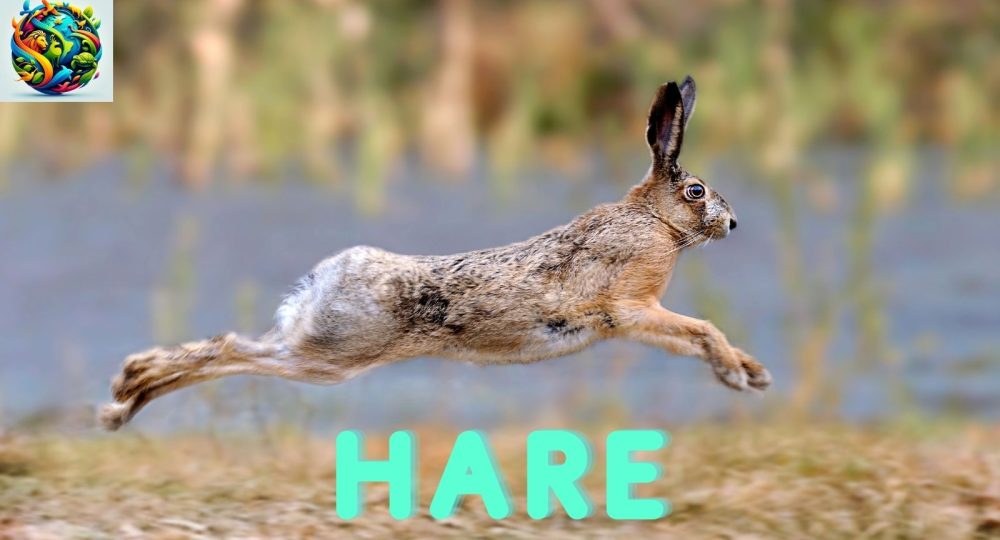Hare: An In-Depth Exploration
Hares, members of the family Leporidae and closely related to rabbits, are swift and agile creatures found in various parts of the world. Known for their long ears, powerful hind legs, and quick reflexes, hares have captivated human interest for centuries, featuring prominently in folklore, literature, and ecology. This article delves into their diverse aspects, exploring their habitats, physical characteristics, behaviors, and more.
Amazing Facts
- They are capable of reaching speeds of up to 45 miles per hour (72 km/h), making them one of the fastest land mammals.
- Unlike rabbits, they are born fully furred and with their eyes open, ready to fend for themselves almost immediately.
- They can leap distances of up to 20 feet (6 meters) in a single bound.
- They have a keen sense of hearing, thanks to their large ears, which can rotate independently to detect predators.
- Their powerful hind legs are adapted for quick, bounding movements, allowing them to evade predators with ease.
- Hares change the color of their fur to blend into their surroundings, especially in snowy environments where they turn white in winter.
- They play a crucial role in their ecosystems, serving as prey for numerous predators and helping control vegetation.
Habitat and Food
They are adaptable animals found in a wide range of habitats, from grasslands and deserts to forests and tundra. Their diet primarily consists of plant material, which they forage for in their natural environments.
Habitat:
They are widespread across Europe, Asia, Africa, and North America.
They prefer open areas such as meadows, fields, and prairies but can also be found in woodland edges and scrublands.
In colder climates, some species, like the Arctic hare, are well adapted to life in snowy and icy conditions.
Food:
Hares are herbivores, primarily feeding on grasses, herbs, twigs, bark, and various other vegetation.
They have a unique digestive system that allows them to re-ingest their feces to extract maximum nutrients from their food, a process known as coprophagy.
Seasonal changes in vegetation influence their diet, with hares consuming different types of plants throughout the year.
Appearance
They are easily recognizable by their distinctive features and athletic build. Key characteristics include:
Ears: Long, with some species having black-tipped ears, used for detecting predators.
Legs: Powerful and elongated hind legs adapted for fast running and long jumps.
Fur: Varies in color depending on the species and environment, often changing with the seasons for camouflage.
Size: Generally larger than rabbits, with some species weighing up to 11 pounds (5 kg) and measuring up to 30 inches (76 cm) in length.
Eyes: Large and set on the sides of their head, providing a wide field of vision to detect danger.
Types/Subspecies of Hares
They belong to the genus Lepus and include numerous species, each adapted to specific environments. Here are some notable species:
European Hare: Found across Europe and parts of Asia, known for its large size and brown fur.
Arctic Hare: Inhabits the Arctic regions of North America and Greenland, with white fur in winter for camouflage.
Snowshoe Hare: Native to North America, famous for its large feet and seasonal fur color change.
Cape Hare: Widespread in Africa and parts of Asia, with a preference for arid and semi-arid habitats.
Black-tailed Jackrabbit: Common in the southwestern United States and Mexico, known for its distinctive black-tipped ears and tail.
Mountain Hare: Found in mountainous regions of Europe and Asia, with fur that turns white in winter.
Predators and Threats
They face numerous predators and threats in their natural habitats, which they counter with their remarkable speed and agility.
Natural Predators:
Mammalian: Foxes, Wolves, Coyotes, Lynxes, and domestic Dogs.
Avian: Eagles, Hawks, and Owls.
Reptilian: Large Snakes in some regions.
Threats:
Habitat Loss: Due to agricultural expansion, urbanization, and deforestation.
Hunting: Both for sport and subsistence, posing a significant threat in some areas.
Climate Change: Affecting habitats and food availability, particularly for species adapted to specific climates.
Disease: Susceptibility to various diseases, including myxomatosis and tularemia.
Mating
They exhibit interesting mating behaviors, which vary among species but generally involve elaborate courtship rituals.
Breeding Season: Typically occurs in spring and summer, though some species may breed year-round in favorable climates.
Courtship: Males compete for the attention of females through displays of strength, such as boxing and chasing.
Gestation and Offspring: Gestation lasts around 42 days, resulting in the birth of leverets (young hares) that are precocial, meaning they are born with fur and open eyes, ready to move and feed shortly after birth.
Litter Size: Varies, with females giving birth to multiple litters per year, each containing 1-8 leverets.
How They Communicate
They use a variety of methods to communicate with each other and their environment, ensuring their survival and social interactions.
Visual Signals:
– Postures and movements, such as sitting up on their hind legs, to signal alertness or threat.
– Ear and tail positions to convey different messages.
Auditory Signals:
– Thumping their hind legs on the ground to warn others of danger.
– Vocalizations, though hares are generally quiet, they can produce sounds like squeals when threatened.
Chemical Signals:
– Scent marking using glands located under their chin and on their paws to establish territory and identify individuals.
Movies Featuring Hares
They have made appearances in various movies, often depicted as cunning, swift, and clever animals.
“Watership Down” (1978, 2018): An animated film based on the novel by Richard Adams, depicting the journey of a group of rabbits and hares.
“Peter Rabbit” (2018): A live-action/CGI film featuring the adventurous Peter Rabbit, a character that shares traits with hares.
“Alice in Wonderland” (1951, 2010): Features the March Hare, a whimsical character known for his eccentric behavior.
“Zootopia” (2016): Features Judy Hopps, a rabbit police officer who exhibits hare-like agility and determination.
FAQs
Q: What is the difference between hares and rabbits?*
A: Hares are generally larger, have longer ears, and are born fully furred with open eyes, while rabbits are smaller, have shorter ears, and are born blind and hairless.
Q: How fast can a they run?
A: Theycan reach speeds of up to 45 miles per hour (72 km/h).
Q: What do they eat?
A: They are herbivores, primarily eating grasses, herbs, twigs, bark, and various other vegetation.
Q: Where do they live?
A: They are found in diverse habitats, including grasslands, deserts, forests, and tundra, across Europe, Asia, Africa, and North America.
Q: How do they communicate?
A: They communicate through visual signals, auditory signals like thumping their hind legs, and chemical signals through scent marking.
Hares are an integral part of many ecosystems, embodying the beauty and complexity of nature. This exploration highlights their unique traits and behaviors, celebrating their role in the natural world.
This Article is Sponsored by FINCTOP & TECHETOP







